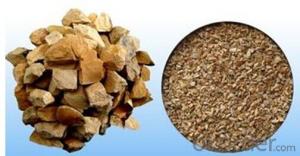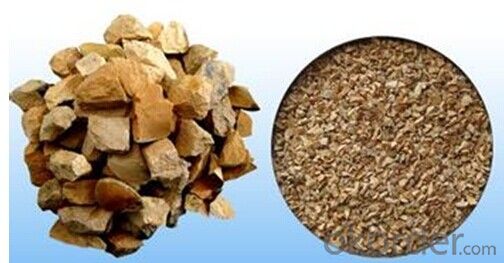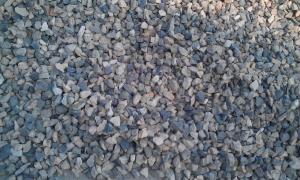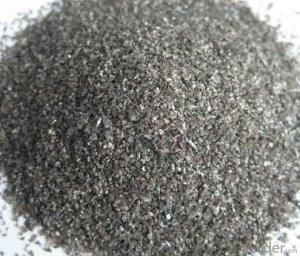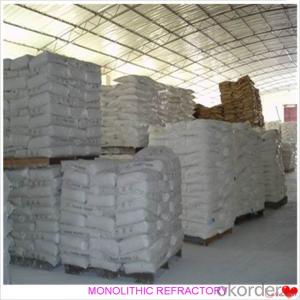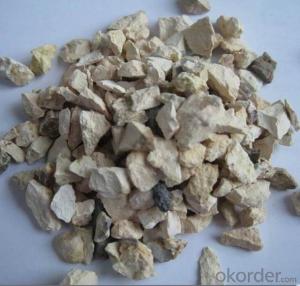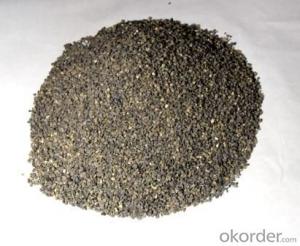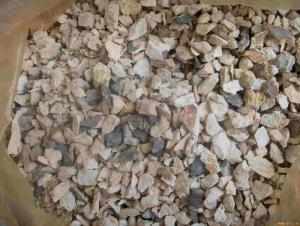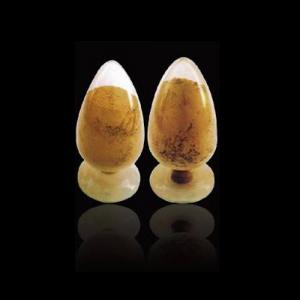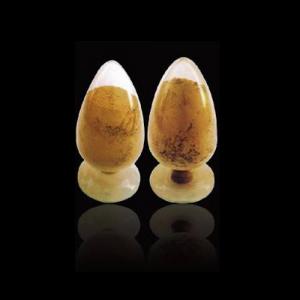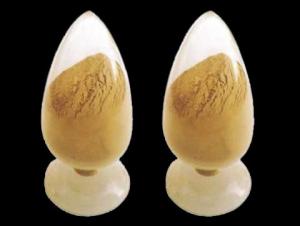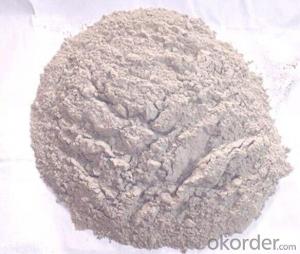Monolithic Refractories for Iron and Steel Industry:High Alumina Raw Bauxite Products
- Loading Port:
- Qingdao
- Payment Terms:
- TT OR LC
- Min Order Qty:
- 400 m.t.
- Supply Capability:
- 5000 m.t./month
OKorder Service Pledge
OKorder Financial Service
You Might Also Like
Specifications
raw bauxite
1. Producing for 20 years.
2. refractory and abrasive
3. Competitive price
4. Al2O3 95%min
It is made by electric arc furnace melting under high temperature of 1100 degrees to 1400 degrees with the raw material of bauxite, anthracite and scrap iron. The main ingredient is AL2O3. With its high micro hardness of 1800-2200kg/mm2, it has many uses like abrasives and refractory. This kind of product has two types P sand and F sand with different uses。
Application:
1. Be used in polishing, grinding.
2. Suitablefor making grinding wheel, cutting, wheel, grinding disc.
3. Its high hardness and abrasion adapt to abrasive tools.
4. For advanced refractory materials
Application | Model | Al2O3 | Na2O | Fe2O3 | SiO2 | TiO2 | LOI | True density | a-Al2O3 | D50 | Particle size | specific surface |
Unit | ≥ % | ≤% | ≤% | ≤% | ≤% | ≤% | g/m3 | ≥ % | um | um | m2/g | |
Dry pressing/CIP series | TCH-101 | 99.7 | 0.08 | 0.02 | 0.018 | 0.006 | 0.15 | 3.96 | 96 | 75 | 2--3 | 0.6-0.8 |
TCH-102 | 99.6 | 0.1 | 0.02 | 0.018 | 0.006 | 0.15 | 3.95 | 95 | 75 | 2--3 | 0.6-0.8 | |
TCH-103 | 99.5 | 0.2 | 0.02 | 0.018 | 0.006 | 0.2 | 3.95 | 95 | 75 | 2--3 | 0.8-1.0 | |
TCH-105 | 99.4 | 0.3 | 0.02 | 0.018 | 0.006 | 0.2 | 3.93 | 93 | 75 | 2--3 | 0.8-1.0 | |
Injection moulding | TCH-213 | 99.5 | 0.15 | 0.02 | 0.018 | 0.006 | 0.15 | 3.95 | 95 | 75 | 3-4 | 0.5-0.6 |
TCH-211 | 99.7 | 0.1 | 0.02 | 0.018 | 0.006 | 0.1 | 3.96 | 96 | 75 | 3-5 |
- Q: How are monolithic refractories different from traditional brick refractories?
- There are several differences between monolithic refractories and traditional brick refractories. Firstly, monolithic refractories are composed of a single, homogeneous material, whereas traditional brick refractories are made up of individual bricks that are pieced together. This variance in construction allows monolithic refractories to possess a more uniform and consistent structure, which can enhance their performance and durability. Secondly, installing monolithic refractories is typically easier compared to traditional brick refractories. Due to their composition, they can be poured or sprayed into place, eliminating the need for precise bricklaying and mortar application. This simplified installation process saves time and labor during construction or repair projects. Furthermore, monolithic refractories often exhibit superior resistance to thermal shock when compared to traditional brick refractories. The homogeneous structure of monolithic refractories enables them to expand and contract more uniformly under thermal stress, reducing the risk of cracking and failure. This characteristic makes monolithic refractories more suitable for applications with rapid temperature changes, such as in furnaces or kilns. Additionally, monolithic refractories offer better resistance to chemical attacks and erosion. Traditional brick refractories may have joints and gaps between bricks, which can become vulnerable to chemical reactions or erosion over time. Conversely, monolithic refractories possess a seamless structure that minimizes the risk of chemical penetration and erosion, enhancing their longevity and performance. In conclusion, monolithic refractories provide advantages in terms of uniformity, ease of installation, thermal shock resistance, and chemical resistance compared to traditional brick refractories. These disparities make monolithic refractories the preferred choice for numerous industrial applications that involve high temperatures and harsh environments.
- Q: How are monolithic refractories inspected and tested for quality assurance?
- To ensure the reliability and performance of monolithic refractories, a series of rigorous processes are conducted for quality assurance. These inspections and tests play a crucial role in maintaining consistent quality standards and identifying any potential defects or weaknesses in the refractory material. The first step involves conducting visual inspections to check for visible defects such as cracks, spalling, or signs of poor manufacturing. This helps in identifying any obvious issues that may affect the refractory's performance. Following that, specialized equipment is used to measure physical properties such as density, porosity, and thermal conductivity. These measurements are then compared against predetermined standards to ensure that the refractory material meets the required specifications. Density and porosity are important indicators of the refractory's strength and resistance to heat and chemicals, while thermal conductivity determines its ability to efficiently transfer heat. Moreover, mechanical tests are performed to assess the refractory's strength and resistance to mechanical stress. This involves subjecting the material to compressive, tensile, and flexural forces to evaluate its structural integrity and durability. To ensure the refractory's suitability for high-temperature environments, thermal tests are conducted. These tests involve exposing the refractory to extreme temperatures and monitoring its behavior. Parameters such as thermal expansion and shrinkage, resistance to thermal shock, and thermal cycling are evaluated during these tests. Chemical analysis is another important aspect of quality assurance for monolithic refractories. Samples of the refractory material are analyzed to determine their chemical composition and assess their resistance to various corrosive environments. This analysis helps ensure that the refractory is suitable for the specific applications it will be used in. Finally, field tests may be conducted at actual operating sites to evaluate the refractory's performance under real-world conditions. These tests involve monitoring the refractory's behavior in terms of wear and tear, thermal insulation, and resistance to chemical attack. The results obtained from field tests are crucial in validating the refractory's performance and making any necessary adjustments to the manufacturing process. In conclusion, monolithic refractories undergo a comprehensive inspection and testing process that includes visual inspections, physical and mechanical tests, thermal analysis, chemical analysis, and field tests. This systematic approach guarantees that the refractories meet the required quality standards, providing reliability and durability in the demanding environments they are designed for.
- Q: How do monolithic refractories resist abrasion in the iron and steel industry?
- Monolithic refractories in the iron and steel industry resist abrasion through their inherent properties and design features. These refractories are formulated with high levels of abrasion-resistant materials such as alumina, silicon carbide, and zirconia, which provide excellent resistance to wear and erosion caused by the movement of molten metal, slag, and other abrasive materials in the production processes. Additionally, the monolithic nature of these refractories eliminates the presence of joints and gaps, reducing weak points and enhancing their ability to withstand abrasion.
- Q: What are the common manufacturing processes used for monolithic refractories?
- The common manufacturing processes used for monolithic refractories include: 1. Mixing: The first step in the manufacturing process is the proper mixing of the raw materials. This involves carefully measuring and combining the different ingredients to ensure a homogeneous mixture. 2. Wetting: Once the ingredients are mixed, water or a liquid binder is added to wet the mixture. This helps in improving the workability and plasticity of the material, making it easier to shape and mold. 3. Forming: The wet mixture is then shaped into the desired form using various techniques such as casting, gunning, ramming, or extrusion. Casting involves pouring the wet mixture into a mold and allowing it to solidify, while gunning uses a spray gun to apply the material onto a surface. Ramming involves compacting the wet mixture into a mold using a ramming tool, and extrusion involves forcing the wet mixture through a die to create specific shapes. 4. Drying: After forming, the shaped monolithic refractory is dried to remove any excess moisture. This is typically done in a controlled environment with specific temperature and humidity conditions to prevent cracking or warping. 5. Firing: Once dried, the monolithic refractory is fired at high temperatures to achieve its desired properties. This process, known as sintering, helps in bonding the particles together and increasing the strength and stability of the material. 6. Finishing: After firing, the monolithic refractory may undergo additional finishing processes such as grinding, polishing, or coating to improve its surface quality and enhance its performance. These common manufacturing processes ensure the production of high-quality monolithic refractories with consistent properties and performance characteristics.
- Q: How do monolithic refractories resist thermal shock in the iron and steel industry?
- Monolithic refractories are designed specifically to withstand thermal shock in the iron and steel industry, achieved primarily through their unique composition and structure. To begin, high-quality raw materials, such as alumina, magnesia, and silica, are used to create monolithic refractories. These materials are chosen carefully for their excellent thermal properties, including a high melting point, low thermal conductivity, and favorable thermal expansion characteristics. The manufacturing process of monolithic refractories involves precise control over the distribution of grain sizes and the addition of bonding agents. This results in a dense and uniform structure, enhancing their resilience against thermal shock. The bonding agents also play a crucial role in strengthening and maintaining the integrity of the refractories. Furthermore, additives are often incorporated into monolithic refractories to increase their resistance to thermal shock. These additives, such as zirconia, silicon carbide, or graphite, enhance the refractories' ability to endure rapid temperature changes. Moreover, monolithic refractories are designed with low porosity to minimize the penetration of molten metal or slag into the material. This helps prevent the formation of cracks and spalling, which can occur due to thermal shock. In addition, monolithic refractories are commonly applied as a lining or coating on furnace surfaces or other equipment. This creates a protective barrier, reducing direct exposure to extreme temperatures and thermal cycling. Overall, the combination of high-quality raw materials, meticulous manufacturing processes, additives, low porosity, and appropriate application techniques make monolithic refractories highly resistant to thermal shock in the iron and steel industry. They can endure rapid temperature changes, prevent cracks, and maintain their structural integrity, ensuring the reliable and efficient operation of furnaces and other equipment in this demanding industry.
- Q: How do monolithic refractories enhance the performance of ladle and tundish preheating systems?
- Monolithic refractories enhance the performance of ladle and tundish preheating systems by providing excellent thermal insulation, high mechanical strength, and resistance to corrosion and erosion. This allows for efficient heat retention and distribution, ensuring uniform and consistent preheating of ladles and tundishes. Additionally, monolithic refractories minimize heat losses, reduce energy consumption, and increase the lifespan of the preheating systems, contributing to improved overall performance.
- Q: What are the main factors affecting the thermal conductivity of monolithic refractories?
- The thermal conductivity of monolithic refractories is affected by various factors. These include the composition of the refractory material, the density of the material, the porosity of the material, and the presence of any additives or impurities. The composition of the refractory material plays a significant role in determining its thermal conductivity. Different types of refractory materials, such as alumina-based, silica-based, or magnesia-based, exhibit different thermal conductivities due to their distinct chemical compositions. Materials with higher alumina content generally display higher thermal conductivities compared to those with higher silica content. The density of the refractory material also impacts its thermal conductivity. Materials with higher densities generally exhibit higher thermal conductivities because the closely packed particles enable more efficient heat transfer. Conversely, materials with lower densities tend to have lower thermal conductivities as the presence of air pockets or voids hinders heat transfer. Another crucial factor is the porosity of the refractory material. Porosity refers to the presence of small pores or spaces within the material. Higher porosity leads to lower thermal conductivity as the air or gas trapped within the pores acts as an insulator, reducing the material's ability to conduct heat. Therefore, materials with lower porosity tend to have higher thermal conductivities. The presence of additives or impurities in the refractory material also affects its thermal conductivity. Certain additives or impurities, such as carbon or metallic oxides, can either enhance or inhibit heat transfer in the material. For example, the addition of carbon can increase thermal conductivity due to its high thermal conductivity, while the presence of metallic oxides may decrease thermal conductivity due to their lower thermal conductivities. In conclusion, the thermal conductivity of monolithic refractories is influenced by factors such as composition, density, porosity, and the presence of additives or impurities. Understanding and controlling these factors are crucial in designing and selecting refractory materials with optimal thermal conductivity for specific applications.
- Q: How do monolithic refractories improve the efficiency of ladle and tundish preheaters?
- The efficiency of ladle and tundish preheaters can be significantly improved through the utilization of monolithic refractories, which play a vital role in this process. To begin with, monolithic refractories possess exceptional thermal insulation properties. Their low thermal conductivity ensures that heat loss from the preheaters is effectively prevented. By minimizing heat loss, monolithic refractories ensure that the majority of the heat generated by the preheater is utilized for preheating the ladle or tundish. This results in reduced energy consumption and enhanced efficiency of the preheating process. Additionally, monolithic refractories offer remarkable resistance to thermal shocks. As ladle and tundish preheaters are subjected to rapid and extreme temperature changes during operation, it is crucial for the refractories to withstand these shocks. The ability of monolithic refractories to endure these thermal shocks ensures their long-lasting performance, reducing the need for frequent repairs or replacements. This not only enhances the efficiency of the preheaters but also reduces downtime and maintenance costs. Furthermore, monolithic refractories exhibit excellent mechanical strength and resistance to abrasion. The constant wear and tear experienced by ladle and tundish preheaters due to the movement of ladles or tundishes, as well as the abrasive nature of the materials being processed, can be mitigated through the use of monolithic refractories. These refractories prevent erosion and damage to the preheaters, ensuring their longevity and optimal functioning. Consequently, this improves the overall efficiency of ladle and tundish preheaters by reducing downtime and maintenance requirements. Lastly, monolithic refractories offer the advantage of design flexibility. They can be customized and shaped to meet the specific requirements of ladle or tundish preheaters. This allows for better fitting and insulation, maximizing heat transfer efficiency. The ability to tailor the refractory lining to the preheater's design also ensures uniform heating, minimizing temperature variations and improving overall operational efficiency. In conclusion, monolithic refractories contribute to the improved efficiency of ladle and tundish preheaters by providing superior thermal insulation, resistance to thermal shocks, mechanical strength, abrasion resistance, and design flexibility. These properties result in reduced heat loss, minimized downtime, enhanced durability, and optimized heat transfer, ultimately leading to improved efficiency of the preheating process.
- Q: How do monolithic refractories perform in electric arc furnace roof applications?
- Monolithic refractories perform well in electric arc furnace roof applications due to their excellent thermal shock resistance, high temperature stability, and superior corrosion resistance. Additionally, monolithic refractories offer easy installation and maintenance, making them a reliable choice for electric arc furnace roofs.
- Q: How do monolithic refractories improve the performance of ladles and tundishes?
- The performance of ladles and tundishes is significantly improved by monolithic refractories in various ways. Firstly, these vessels are thermally insulated by monolithic refractories, which act as a barrier against heat loss and help maintain the desired temperature. This insulation reduces energy consumption and minimizes heat loss. Secondly, monolithic refractories offer excellent resistance to chemical corrosion and erosion. When ladles and tundishes come into contact with molten metal and fluxes, they can be severely corroded and eroded. However, the use of monolithic refractories protects against chemical attacks and extends the lifespan of these vessels. This saves costs associated with frequent repairs or replacements and ensures their integrity and safety. Furthermore, monolithic refractories provide superior mechanical strength and structural stability. Ladles and tundishes must withstand the weight of molten metal and the stresses caused during pouring and handling. With high mechanical strength, monolithic refractories can withstand these loads, maintaining their shape and integrity. This reduces downtime and increases productivity in the steelmaking process. Moreover, monolithic refractories offer flexibility in design and installation. They can be shaped and applied in various configurations, allowing customization to meet the specific requirements of ladles and tundishes. This flexibility ensures a better fit and improves the overall efficiency of the refractories, ultimately enhancing the performance of the vessels. In conclusion, monolithic refractories enhance the performance of ladles and tundishes by providing improved thermal insulation, resistance to chemical corrosion and erosion, increased mechanical strength, and flexibility in design and installation. These benefits contribute to the longevity, efficiency, and cost-effectiveness of ladles and tundishes in steelmaking operations.
Send your message to us
Monolithic Refractories for Iron and Steel Industry:High Alumina Raw Bauxite Products
- Loading Port:
- Qingdao
- Payment Terms:
- TT OR LC
- Min Order Qty:
- 400 m.t.
- Supply Capability:
- 5000 m.t./month
OKorder Service Pledge
OKorder Financial Service
Similar products
Hot products
Hot Searches
Related keywords
